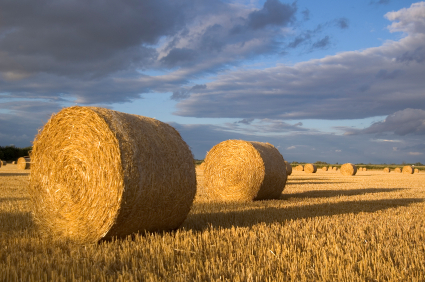Cellulosic ethanol, after 30 years of R&D (much of it on the public dime), is ready to deliver on its promises. No longer perpetually five years away from commercial viability, the technology has come into its own. Unlike pretender energy sources like wind and solar, cellulosic is the “‘shovel-ready,’ ‘fire when ready’ technology for short-term reductions in fossil fuel intensity,” declares Biofuels Digest in a breathless post. According to BD, “commercial-scale cellulosic ethanol is just now upon us.” Forget the “five years away” mantra; “it’s time to party like it’s 2014,” the publication enthuses.
 Hay: probably not about to displace crude oil as a major car fuel.Mind you that under the 2007 Energy Act’s Renewable Fuel Standard, gasoline makers are mandated to blend in a billion gallons of cellulosic ethanol in 2013–stair-stepping up to 16 billion gallons by 2022. And if the current ethanol tax code holds up, blenders will get a fat $0.45/gallon credit for blending the stuff–a de facto subsidy to the industry worth billions of dollars per year.
Hay: probably not about to displace crude oil as a major car fuel.Mind you that under the 2007 Energy Act’s Renewable Fuel Standard, gasoline makers are mandated to blend in a billion gallons of cellulosic ethanol in 2013–stair-stepping up to 16 billion gallons by 2022. And if the current ethanol tax code holds up, blenders will get a fat $0.45/gallon credit for blending the stuff–a de facto subsidy to the industry worth billions of dollars per year.
So is the industry ready to cash in? Not really, if you read Biofuels Digest critically. If cellulosic ethanol were ready for prime time, Biuofuels Digest would be announcing the opening of commercial-scale facilities capable of churning out hundreds of millions of gallons of product. Instead, it’s promising a bunch of small projects. In 2010, the publication reports, “Verenium will break ground on a 36 Mgy [Mgy=million gallons per year] plant in Florida. Range Fuels will commence production at its 25 Mgy Soperton Plant in Q2.”
In 2011 …
INEOS Bio will commence production at its first commercial scale facility by year end–capacity not yet disclosed. Iogen is expecting to commence production at its the 23 Mgy plant north of Saskatoon by year end, using wheat straw and other cellulose as feedstock. POET’s 25 Mgy Project LIBERTY plant in Emmetsburg, Iowa is expected to open by year end, using corn cobs as feedstock. BlueFire and Abengoa’s demonstration plants are projected to open in Lancaster, CA and Hugoton, KS by year end.
In other words, a bunch of small-scale plants. What about 2012?
Vernium’s 36 Mgy plant projected to open in Florida. Coskata is expecting to open its first 50-60 Mgy plant in the US Southeast by year end. Mascoma expects to open its 20 Mgy cellulosic ethanol demonstration scale plant in Kinross, Michigan in September. KL Energy is aiming to open five 12-25 Mgy plants by mid-year – at locations on three continents.
Even taking these projections at face value–traditionally not a wise move when it comes to cellulosic–we’re not seeing a lot of capacity here. Then we get the kicker: “BP said that it will commence production of cellulosic ethanol from biomass in Brazil in 2013.” Promises, promises!
Far from being “just now upon us,” cellulosic ethanol is looking, oh, about five years away. And it may stay that way. There just isn’t that much energy in plant cellulose–and hauling bulky material like hay from field to factory burns up lots of energy. Rather than dump billions of dollars into trying to displace energy-rich crude oil with energy-light hay, why not invest in technologies that are proven to conserve energy–like high-speed trains to compete with the fuel-sucking airline industry?


